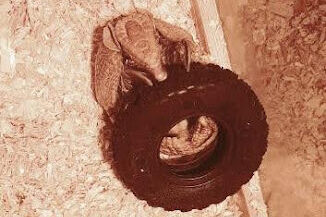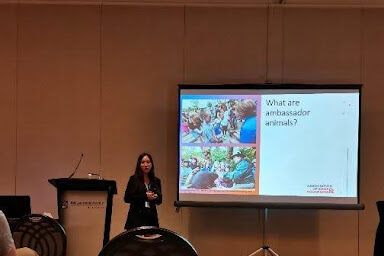By Shao Doyon-Degroote, a former Master student at Concordia University
During the summer of 2022, I had the amazing opportunity to study animal behavior and to work in two great zoological institutions in Québec: The Zoo de Granby and the Ecomuseum Zoo of Montréal. The objective of my research was to study the physiological and behavioral impacts of ambassador animals used in education programs. But what exactly does that mean? To begin, I must clarify that not all zoo animals are the same, with different animals having different purposes. The ones that visitors encounter in the zoo are exhibited animals, whereas the ones used in workshops, programmed shows, or school activities are ambassador animals. The latter are frequently handled and transported for educational activities, so it is important to assess their welfare.
The general aim of my project was to examine if ambassadors were more stressed after participating in activities than when they are at rest, not experiencing potential stressors. To measure behavioral stress, I used two indicators: the proportion of time spent on undesirable behaviors, like pacing, and the variation in time spent on active and passive behaviors after participating in activities. To quantify stress with a physiological indicator, I analyzed the concentration of two stress hormones found in feces samples. My objectives in this study were to:
- find potential sources of stressors (e.g., handling and transport) across ambassador animals in response to educational programs,
- determine the variation of potential stress indicators (both behavioral and physiological) according to the animals’ activities,
- establish a baseline and threshold indicators of wellbeing for each species,
- study intra- and inter-variations of stress responses within mammals, reptiles, and birds, and
- propose improvements to current management practices to enhance the welfare of ambassador animals.

I studied eight ambassador species from different animal classes: the Bactrian camel, the dromedary, the three-banded armadillo, the grey short-tailed opossum, the blue-tongued skink, the ball python, the American kestrel, and the Great-Horned owl. From May to September 2023, I collected behavioral (Fig. 2) and physiological data (Fig. 3) for four different treatments: at rest (i.e., the control), after rides for camelid species, after zoo workshops, and after school workshops. I also noted the influence of other variables like the time of the day, the presence or absence of environmental enrichments, the enclosure setting, and the absence of conspecifics for individuals housed in groups.

Overall, ambassador animals were well taken care of by the zookeepers and animal welfare was a top priority for the managers of the Zoo de Granby and the Ecomuseum Zoo. Although the stress hormone concentrations were high in camels and opossums, the mean stress hormone concentration did not exceed established thresholds from the other species. There was no evidence of poor welfare for any ambassador.
That being said, a few fecal samples had high stress hormone concentrations after individuals participated in activities and I found the amount individuals were used in activities significantly affected their physiological stress. The individuals that were used the least in the activities had their stress hormone concentration peak sooner than the individuals most used, which suggests that the more animals participate in activities, the more they become habituated and physiologic stress response after several activities is delayed. Moreover, I found that the performance of undesirable behaviors could potentially exceed the desired threshold in camels, dromedaries, armadillos, and pythons, with some individuals spending more than 10% of their time on undesirable behaviors. By looking at the activity budgets for each species, I was able to determine when those behaviors were more frequent and was able to find potential solutions. For example, one of the most powerful tools to stimulate captive animals and decrease undesirable behaviors is by offering different environmental enrichments (Fig. 4-5). Whether they have food hidden in them, they have a different smell or texture, they are interactive or they modify the enclosure’s structure, enrichments can be very beneficial and – as the name says – enriching for the animals.


To this day, I have presented the results of my research at the Assiniboine Park Zoo in Winnipeg, the Zoo de Granby, as well as at the Annual Congress of the Société Québécoise pour l’Étude Biologique du Comportement (SQEBC) in Gatineau (2022) and the Annual Meeting of the Canadian Society for Ecology and Evolution (CSEE) in Winnipeg (2023). My next step is to share my findings at the Annual Meeting of the Association of Zoos and Aquariums in Columbus in September 2023. I am very grateful for the opportunity that I had to study zoo animals and for all the incredible people working in zoological facilities that I have met. If there is one thing that I learned from this experience, it’s that not all individuals will have the same stress response, so it is crucial to take animal welfare seriously not only at the species level but also at the individual level. I also hope that more studies will be conducted on this important subject.


About the author: Shao Doyon-Degroot is a former MSc student at Concordia University, studying within Dr. Robert Weladji’s laboratory.

0 Comments